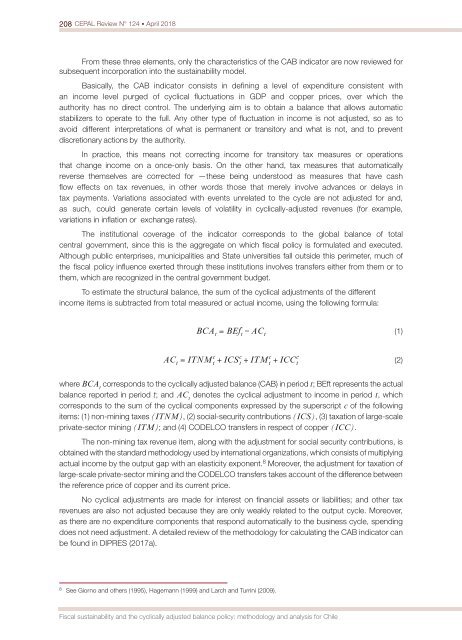CEPAL Review no. 124
April 2018
April 2018
You also want an ePaper? Increase the reach of your titles
YUMPU automatically turns print PDFs into web optimized ePapers that Google loves.
208 <strong>CEPAL</strong> <strong>Review</strong> N° <strong>124</strong> • April 2018<br />
From these three elements, only the characteristics of the CAB indicator are <strong>no</strong>w reviewed for<br />
subsequent incorporation into the sustainability model.<br />
Basically, the CAB indicator consists in defining a level of expenditure consistent with<br />
an income level purged of cyclical fluctuations in GDP and copper prices, over which the<br />
authority has <strong>no</strong> direct control. The underlying aim is to obtain a balance that allows automatic<br />
stabilizers to operate to the full. Any other type of fluctuation in income is <strong>no</strong>t adjusted, so as to<br />
avoid different interpretations of what is permanent or transitory and what is <strong>no</strong>t, and to prevent<br />
discretionary actions by the authority.<br />
In practice, this means <strong>no</strong>t correcting income for transitory tax measures or operations<br />
that change income on a once-only basis. On the other hand, tax measures that automatically<br />
reverse themselves are corrected for —these being understood as measures that have cash<br />
flow effects on tax revenues, in other words those that merely involve advances or delays in<br />
tax payments. Variations associated with events unrelated to the cycle are <strong>no</strong>t adjusted for and,<br />
as such, could generate certain levels of volatility in cyclically-adjusted revenues (for example,<br />
variations in inflation or exchange rates).<br />
The institutional coverage of the indicator corresponds to the global balance of total<br />
central government, since this is the aggregate on which fiscal policy is formulated and executed.<br />
Although public enterprises, municipalities and State universities fall outside this perimeter, much of<br />
the fiscal policy influence exerted through these institutions involves transfers either from them or to<br />
them, which are recognized in the central government budget.<br />
To estimate the structural balance, the sum of the cyclical adjustments of the different<br />
income items is subtracted from total measured or actual income, using the following formula:<br />
(1)<br />
(2)<br />
where BCA t<br />
corresponds to the cyclically adjusted balance (CAB) in period t; BEft represents the actual<br />
balance reported in period t; and AC t<br />
de<strong>no</strong>tes the cyclical adjustment to income in period t, which<br />
corresponds to the sum of the cyclical components expressed by the superscript c of the following<br />
items: (1) <strong>no</strong>n-mining taxes (ITNM), (2) social-security contributions (ICS), (3) taxation of large-scale<br />
private-sector mining (ITM); and (4) CODELCO transfers in respect of copper (ICC).<br />
The <strong>no</strong>n-mining tax revenue item, along with the adjustment for social security contributions, is<br />
obtained with the standard methodology used by international organizations, which consists of multiplying<br />
actual income by the output gap with an elasticity exponent. 8 Moreover, the adjustment for taxation of<br />
large-scale private-sector mining and the CODELCO transfers takes account of the difference between<br />
the reference price of copper and its current price.<br />
No cyclical adjustments are made for interest on financial assets or liabilities; and other tax<br />
revenues are also <strong>no</strong>t adjusted because they are only weakly related to the output cycle. Moreover,<br />
as there are <strong>no</strong> expenditure components that respond automatically to the business cycle, spending<br />
does <strong>no</strong>t need adjustment. A detailed review of the methodology for calculating the CAB indicator can<br />
be found in DIPRES (2017a).<br />
8<br />
See Gior<strong>no</strong> and others (1995), Hagemann (1999) and Larch and Turrini (2009).<br />
Fiscal sustainability and the cyclically adjusted balance policy: methodology and analysis for Chile


















